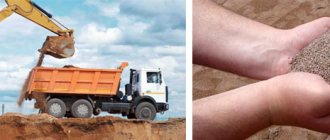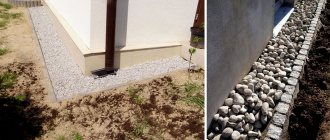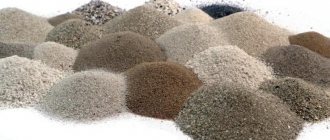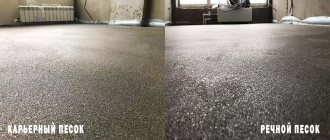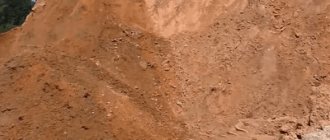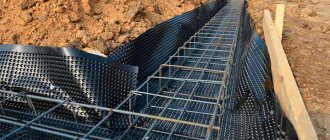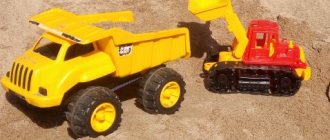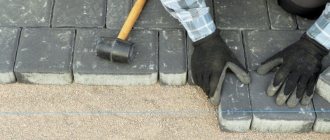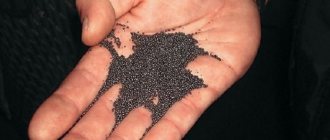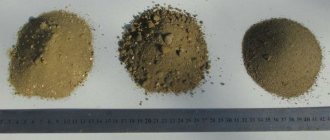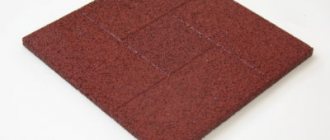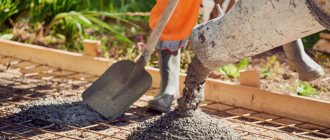Types of quarry sand and their differences
Before we talk about the use of quarry construction sand, it is necessary to understand what types of material can be found and what are their differences. Sand is usually classified and divided according to grain size and processing method.
Depending on the grain size, it can be:
- fine-grained (grains of sand should be no more than 0.2 cm in diameter);
- medium-grained (with a diameter from 0.2 to 0.28 cm);
- coarse-grained (diameter reaches 0.5 cm).
According to the processing method, it is divided into:
- seeded;
- alluvial;
- sandy.
To obtain a seeded appearance, you need to use sifting, due to which large and small stones can be removed from the material. The resulting mixture can be used to create cement mortars and for mixing plaster. Alluvial is a mixture without any impurities, which is obtained through high-quality processing. The main area of application is the production of bricks and concrete products. The sandy type is considered the easiest to extract; it also contains a small amount of various impurities. It is mainly used for leveling terrain and for filling holes.
Quarry sand mining
The most common and less expensive mining method is open-pit mining. With this technology, only quarry equipment is needed: excavators, heavy-duty vehicles. Before mining, the top layer of soil or clay is removed. If there is water in the quarry, it is drained using drainage systems. After extraction, the material can be sifted and washed, due to which it acquires different properties and changes in value. In addition, sand is divided into fractions. The scope of application of building materials also depends on this. When sand is mined in an open-pit manner, large costs are not expected, due to which the low cost of the finished product is determined.
Features and characteristics of quarry sand
The grains of the raw material have an average size of 0.2 cm. Quarry sand, when compared with other varieties, contains about 10% of various additives. The color starts from yellow and ends with brown - the shade of the grains is affected by the mineral additives in the composition. The shape of sand grains is uneven, the surface can be porous, which ensures better adhesion to cement. Thanks to this, quarry sand is considered one of the best and inexpensive building materials. The specific gravity may be different for different fractions.
If we are talking about the fine-grained type, then the weight is approximately 1700 kg/m3, if we are talking about the medium- and coarse-grained type, this characteristic is approximately 1600 kg/m3. It also needs to be said about density, which depends on the composition - the more additives in the composition, the higher the level of density. This indicator also depends on the size and fraction - the higher the fraction, the lower the density level. Other characteristics include humidity, which affects the weight of the composition.
For high-quality construction sand, the humidity level should not exceed 7%. The content of impurities and additives should be at the level of 3%, sulfur - no more than 1%.
Only in this case can we talk about a high-quality mixture. When choosing a material, do not forget about the level of radioactivity, which depends on where it is mined. The mixture collected in mountainous areas, as a rule, is characterized by a higher radioactive background. When choosing a composition for construction, you should pay attention to material of class 1; for road work it is permissible to use classes 2 and 3.
Content of dust and clay particles
A high content of clay and dust elements can negatively affect the quality of the solution and concrete products, so the value of this parameter must be taken into account when purchasing.
According to GOST, the content of dust and clay particles in quarry sand should be up to 7%. The indicator varies depending on the class and size modulus of the material. In the quarries of our region, sand containing from 0.5 to 2.2% of such particles is extracted. This means it's pretty clean.
You can also find out whether the sand contains foreign impurities through a visual inspection.
Please note the following photo:
On the left is a sample of unprocessed quarry sand, which is sold immediately after extraction. On the right is washed quarry sand (otherwise it is also called alluvial sand). The color of the left sample is richer and darker due to admixtures of clay particles, while the right one is lighter and purer.
Does quarry sand have any advantages and what are the disadvantages?
The main advantage of the material is its naturalness and environmental friendliness - quarry sand does not cause allergies. In addition, it is non-toxic, and therefore can be used for arranging children's playgrounds. It is also classified as a fireproof material that does not burn and does not emit harmful substances when heated. But the main advantage of the material can be called low cost, which is caused by several factors:
- companies do not spend a lot of money on extracting and processing the mixture;
- the process of extracting material is very simple and does not require the use of expensive machinery and equipment;
- low delivery cost - there are a lot of sand quarries, so you can always find the right amount of material near your home.
There are, of course, some disadvantages. These include the fact that unrefined and unsifted quarry sand contains on average about 10% clay and other impurities. This is what limits the scope of application of the material in construction and improvement.
Radioactivity
GOSTs have approved three classes of radioactivity for building materials. In our region, sand of the first, safest class is mined. The specific effective activity of natural radionuclides in it does not exceed 370 Bq/kg. For example, at one of the deposits material with indicators of up to 39.6 Bq/kg is extracted. On the other, this figure is slightly higher – 46.3 Bq/kg. But still, this is much lower than the upper limit of the safest group. This sand can be used in any type of construction, including the construction of residential buildings.
In what areas can quarry sand be used?
The area of use of the material depends on the quality of its composition. So, if we are talking about an inexpensive material with low characteristics, then it can be used during agricultural work to improve the composition of the soil, in landscape design, in particular, for filling ditches and holes. In winter, sand is used to sprinkle paths so that it is not so slippery. In addition, many summer residents use it to store vegetables and fruits in the cellar for the winter.
Often, “grains” are used as a kind of filter in treatment buildings, for arranging embankments and when leveling construction sites. Screened construction sand has found its application in the construction of structures at the foundation stage, for the creation of cement mixtures and asphalt. Excellent adhesive properties allow the material to be used in finishing works as one of the components of plaster and cement.
Washed fine-grained construction sand is best used in the manufacture of dry compounds. It is also added for the manufacture of putties, into the mixture when creating self-leveling floors and other materials necessary for interior finishing. True, in this case it is necessary to use sifted or washed sand, which does not contain any organic additives or stones.
Application of sand by type
- Quarry sand is a sedimentary rock mined in quarries in the Kaluga and Moscow regions. It has the widest scope of application: construction of buildings and structures, concrete production, road work, landscaping, gardening work, backfilling and much more.
- River sand is perhaps the purest type of sand, which does not require washing and sifting, because it is purified naturally during the movement of water in a river or other body of water. It has a minimal content of clay and loam in its composition. Used in landscape design, for the preparation of cement mortars and concrete, for drainage systems and filtration systems.
- Seeded sand is a type of quarry sand that has been additionally sifted and cleaned of impurities: clay, loam, gravel. Pure seeded sand is indispensable for plastering work, in the manufacture of foundations, asphalt concrete mixtures and mortar for laying bricks or even tiles.
- Washed sand is similar in its characteristics and scope of application to river sand, but differs in the extraction method. Washed sand is mined in quarries and then washed with special equipment (hydraulic washing method) to remove clay, dust particles, gravel and other impurities. This type of sand is used mainly for the production of concrete, cement and plaster mixtures.
- Construction sand is natural quarry sand, indispensable for all stages of construction: private, civil, industrial, road. It is considered a universal bulk building material.
When ordering sand, be sure to ask the supplier for real photos of the material. This way you can visually assess the color of the sand and see if it contains large impurities. In addition, when the sand is delivered to you, measure its volume in the back of the car before unloading. Unscrupulous suppliers and carriers are famous for underloading. To avoid overpayment and further shortage of material, take a tape measure and measure the volume of sand as soon as it is delivered to you.
Sand is a universal and most affordable material. Now it has become easier to buy sand in Moscow. We have 3 of our own transshipment bases and a fleet of special equipment: we have enough space and capabilities to store 250,000 cubic meters of bulk materials and quickly deliver them to the north and south of Moscow and the Moscow region.
The main differences between quarry and river sand
Many people often confuse river and quarry sand, but they have significant differences in their composition and scope of application. Thus, river sand contains an average of 1% clay additives, while quarry sand contains 10% or more. Because of this, you should not use uncleaned sand during construction work - this can reduce the strength of the material and structures. Sand also differs in cost - river sand is much more expensive, which can be explained by the large financial costs of finding, mining and subsequent processing.
The chemical composition of quarry sand makes it unsuitable for a range of repair and construction work, but it is excellent for use in areas where high demands are not placed on the materials. True, the smoother shape of river sand does not provide proper adhesion, and therefore experts recommend using quarry sand for the production of building mixtures. Quite often difficulties arise with the choice of material. The low cost of the material extracted from the quarry becomes one of the most common arguments when purchasing it.
But we must not forget about some restrictions that are imposed on the material during operation. In some cases, skimping on quality can lead to further serious problems during construction. So, if construction sand is not used for its intended purpose, the structure built with it may collapse in the future. But at the same time, the processed material has similar qualities and properties to river sand, while the price of quarry sand is much lower. That is why, when purchasing a material, carefully study its characteristics and composition in order to accurately purchase high-quality material.
- Author: Mikhail Malofeev
Rate this article:
- 5
- 4
- 3
- 2
- 1
(0 votes, average: 0 out of 5)
Share with your friends!
Pros of buying sand in
If you are now looking for a reliable partner, here are 5 good reasons to contact us.
- Own production . Eco-Shcheben is a manufacturing company, not just a supplier. This means that we do not depend on intermediaries and are responsible for the constant availability and quality of goods. And most importantly, we do not increase prices as resellers.
- 3 production transshipment sites in the south and north of Moscow. They are located geographically to make delivery faster and cheaper for you. They work around the clock and always welcome guests. You can come at any time, make sure the sand is available and evaluate its quality. Pickup and shipment of bulk materials from bases occurs 24/7.
- 12 dump trucks in our fleet. A large selection of vehicles with body volume from 10 to 32 m³ allows us to offer you the most successful logistics solutions. Need 10 cubic meters of sand? Ok, we’ll use our most compact dump truck and deliver the sand to your summer cottage. Do you take large volumes? Then a MAN Tonar with a load of up to 32 cubic meters will arrive at your construction or road site. All our equipment is on the company’s balance sheet, and this once again confirms that we are not a fly-by-night company and can be trusted.
- Shipment by scales. We always ship sand by weight, so rest assured that the volume is accurate. If you want to check it out, come to one of our bases. In front of you, we will weigh the empty car, load it with sand and weigh it again. You will see with your own eyes the process and accuracy of measurements.
- Payment by credit card on the spot. In addition to cash and non-cash payments, you can pay for your order with a VISA or Mastercard card on the spot, through a mobile terminal. Now you don’t have to collect and look for cash or use complex services for cashless payments. Pay with any of your cards, it's convenient.
